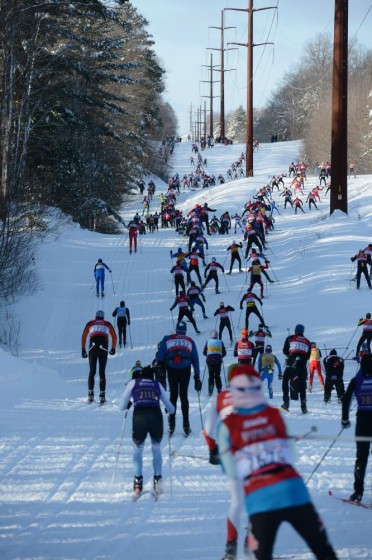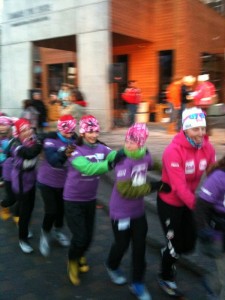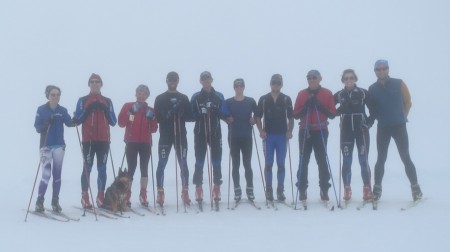
Did you recently get an email in your inbox from Kikkan Randall?
If so, you’re likely one of the 24,000 American Birkebeiner racers who have been asked about their health and exercise habits as part of a study by Mayo Clinic researcher Dr. Paul Anderson.
“Primarily, the study came out of my own interest in helping people get active,” Anderson said in a phone interview this week. “I thought it would be really interesting to study Birkie skiers because citizen athletes represent what I consider to be a beacon of hope for the public health challenge of getting people to be more physically active. So I want to know more about exactly how they start and maintain their training for the race – especially related to their social support for exercise. I’m a Birkie skier myself and really love Nordic skiing, so I started there.”
Anderson spent five years working in Alaska in an occupational and environmental health, and is now doing a fellowship at the Mayo Clinic in preventative medicine.
“Instead of looking at people who are ill and trying to understand their disease, I’ve done research in the past that studies people who are well, or elite performers,” he explained.
And Birkie skiers, he estimates, are just that. By studying their habits he hopes that he can learn something about what it would take to get more Americans off their sofas.
According to Anderson, he approached American Birkebeiner Ski Foundation Executive Director Ben Popp about whether the organization would be interested in collaborating on a study, and Popp immediately agreed.
Anderson was expecting perhaps to just offer a survey at the Birkie itself, but Popp offered to turn over contacts for every skier who has ever done a Birkie event. So far, after just one week, about 10% of the 24,000 individuals have already completed the survey.

For Randall, the project is a perfect fit. A three-time FIS World Cup Sprint champ, she also heads the U.S. division of Fast and Female, which is on its way to being its own nonprofit. Getting people active, and keeping them involved in sports, is one of her pet projects.
Reached by phone, Randall was every bit as excited about the Birkie study as she was in her e-mail to potential study participants.
“He invited me to be a part of it thinking that we could get it a little bit more attention, and he thought it might be something I would be interested in – which I definitely am,” she said. “I’m curious about what drives people to be active and what positive effect it can have. I’m really excited to see what comes of the study.”
How exactly will Anderson tackle those questions? He described diving deep into the literature of a field called social cognitive theory. As an example, he talked about someone who was quitting smoking: to do so, they need the support of people in their social network. To start exercising or to train for a big event, people are also boosted by support from friends and family. But how essential is this and how much support is needed? Anderson adapted the questions asked by social cognitive theory to skiing.
“There are questions you can ask people about social support in a number of contexts,” Anderson said. “I put that together with my own story: somebody introduced me to Nordic skiing, somebody taught me what I needed to know and supported me a lot in getting active in this particular way during the winter time. I think that raised the question for me, how much and what kind of social support do citizen athletes need to both to get started and to maintain their participation in events like the Birkie.”
For instance, the survey asks how often skiers meet up with a friend for training, or whether their friends or family congratulate them for exercising or racing.
A second aspect of the survey has to do with general health habits. Anderson mirrored some of the questions on the Behavioral Risk Factor Surveillance System, an annual survey administered by the Centers for Disease Control all around the U.S. By doing so, he will be able to compare citizen athletes’ habits to those of the general public.
“That’s in terms of exercise behaviors, how many fruits and vegetables they eat, smoking, alcohol use,” he explained. “One of the biggest challenges we have in public health is to show that it makes any difference whatsoever. I think [Birkie skiers are] a group of people who follow probably most of the – well, except drinking – who follow most of the public health recommendations that we would idealize. So to show that they have a completely different set of health behaviors than the general public, and that they demonstrate the value of promoting physical activity.”
He also said that he will assess whether health habits or the level of social support differ by sex, marital status, or socioeconomic status.

For someone like Randall, who is interested in lifelong participation in sports in general but particularly for girls and women, this represents a particularly exciting development.
“Why people choose to get out in the first place, and what keeps them staying active, especially when we’re talking about the social aspect of it which is super huge for girls and women – I’m super interested to look at the results and glean some things from it that we can apply to Fast and Female so that we can continue to make our programming more effective, and really work towards achieving our mission of keeping girls and women involved in sports for their whole lives,” she said.
In a post-Olympic year, Randall is finding more and more chances to work on projects that tackle public health and exercise.
“I wouldn’t say that there’s necessarily a whole lot more time, but to me, I have a hard time passing up cool opportunities like this to either learn more or hopefully help build programs to get people more healthy and active,” she explained. “So certainly there’s less interviews and a few less things to run around and do with the Olympics being over, but I still have managed to fill my plate with Fast and Female, this, and the Nordic Rocks program that CXC started to get more kids in the cities on skis.”
For Anderson, there’s the possibility of more work on Birkie athletes in the future – for example long-term studies. In Sweden, researchers have been following a cohort of Vasaloppet skiers, finding for instance that lifelong skiers have an increased incidence of heart arrhythmia.
A longitudinal study of social behavior might be in the future, but for now, Anderson is focusing on the task at hand.
“What we set out to do was execute a careful, fairly small, well done study to show the ease and value of studying citizen athletes,” he said. “We don’t want people to experience our health survey at the race and ask ‘why did they do that? It wasn’t very well done.’ So we do this study, we get good results, we say something concrete, and we learn something. Then hopefully we learn and interest in further studies can grow… There are so many potential questions out there, but we want to do this first, do it really well, and then we’ll ask some of these bigger questions more precisely in the future.”
If people have participated in the Birkie and would like to take the survey but did not get a survey in the mail, please send an email to anderson.paul1@mayo.edu before the end of November and he’ll get you a survey. Results will be presented in a generalized format at the 2015 American Birkebeiner and also published in a variety of formats.
Chelsea Little
Chelsea Little is FasterSkier's Editor-At-Large. A former racer at Ford Sayre, Dartmouth College and the Craftsbury Green Racing Project, she is a PhD candidate in aquatic ecology in the @Altermatt_lab at Eawag, the Swiss Federal Institute of Aquatic Science and Technology in Zurich, Switzerland. You can follow her on twitter @ChelskiLittle.



